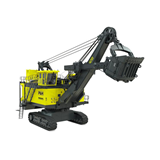No I am not pulling the wool over your eyes, there is a global industry of Alpaca breeders and wool exporters and Australia has played a part in developing its international potential. Whilst Alpacas may be native to Peru there are now breeders in Australia, New Zealand, and South Africa and even in Europe and North America. Whist addressing the World Alpaca Conference in Sydney’s Darling Harbour, Austrade CEO Peter O’Byrne pointed out that whilst Alpacas are truly Peruvian, Australia had been able to “add value to the industry in terms of fibre technology transfer and training, veterinary skills, and helping open up the Asian market for Alpaca fleeces.”
But what other interests does Australia have in Peru apart from our fluffy friends the Alpacas? According to Nicholas Baker, Australia’s Trade Commissioner in Lima, there’s a new ‘El Dorado’ in Peru and the other Andean countries in terms of mining and exploration.
“We not only have the multinational mining giants like BHP Billiton, Rio Tinto and Xstrata Copper but we also have exporters like Gekko, Ryco Hydraulics and Caterpillar-Elphinstone who help provide technology, training and infrastructure to Peru’s burgeoning resources sector,” he explained.
In addition, outside mining a number of other Australian companies have a presence in Peru including Orica Chemicals and Mining, Amcor PET Packaging, Codan (radio communications) and Southern Cross Alliance (a migration service). I also noticed on my last visit to Peru, a large number of Billabong outlets, as Peru has its own surf culture (In fact, Billabong can be found all over the Americas, Europe, South Africa and Asia so it’s no wonder that Billabong now earns more revenue off shore than Westpac Bank!). According to Nicholas Baker, Austrade now helps almost 100 companies in Peru to the export value of more than $98 million so there’s good reason to be optimistic about the new El Dorado.
In fact, the increasing interest in Peru from Australian companies reflects growing ties between Australian and Latin America as a whole. Latin America is performing better economically than now than in its more recent past, which has seen Australia’s trade with the region grow at 23 per cent annually over the past half-decade or so with Australia’s merchandise exports reaching around $2.3 billion in 2006-07.
Most Latin American countries are growing and are relatively stable in the 2000s and 1990s compared to the more turbulent 1970s and 1980s. With the exception of Argentina, most South American economies have experienced steady growth and Mexico has performed consistently for the past decade. Banco Santander Chief Economist for Latin America, the New York based, Ernest ‘Chip’ Brown told Australian investors at the Excellence in Investment: Latin America 2008 conference, that the region could “continue to expect growth in the 4-5 per cent range over the 2000s, because of the strong global outlook for global commodities in general” and the fact that Latin American policy-makers had “largely done the right thing in terms of fiscal and monetary policy although microeconomic reform had a long way to go especially in Argentina.”
Whilst Latin American economists themselves are closely watching the sub-prime crisis in the North it is expected that the South American economies are better placed than in the past because of the growth of intra-Latin American trade (similarly with intra-Asian trade), stronger Latin American links with Asia (through APEC) and structural improvements in there own economies. Of course, Mexico is closely linked trade-wise with the North through NAFTA, although Latin American economists believe Mexican exports and imports will move together avoiding a major external shock. There is some concern, however, about a lack of foreign direct investment (FDI) in Argentina. For instance, neighbouring Chile, which is a much smaller economy than Argentina is receiving five times its level of FDI, according to Banco Santander estimates.
- Suppliers
- New to IndustrySearch? Book a Demo
- Advertise with us
- Login
- Email Marketing
- Buyers
- Get Quotes
- Articles & Ideas
- Login
- Subscribe to newsletter
- My Details
- Get Quotes
- Automation & Control
- Automotive Workshop Equipment
- Commercial Cleaning Equipment & Supplies
- Construction Equipment & Heavy Machinery
- Conveyor Systems & Components
- Electrical & Power Generation Equipment
- Electronic Components
- Farming & Agriculture
- Food & Beverage Processing
- Forklifts & Forklift Attachments
- Hydraulic & Pneumatic Equipment
- Industrial Materials, Tools & Components
- Industrial Pumps
- IT Hardware & Industrial Computing
- IT Software & Applications
- Laboratory Equipment & Instruments
- Manufacturing & Industrial Equipment
- Material Handling & Lifting Equipment
- Metalworking & Machining
- Mining Equipment & Machinery
- Packaging & Labelling Machinery
- Pallet Handling Equipment
- Personal Protective Equipment
- Security & Surveillance
- Test & Measurement
- Transport & Logistic Equipment
- Warehouse Storage, Shelving & Racking
- Waste Treatment & Environmental Management
- Welding Machines & Accessories
- Woodworking & Joinery Machines
- Workplace Equipment
- Workplace Safety Equipment
- Get Quotes
- Automation & Control
- Automotive Workshop Equipment
- Commercial Cleaning Equipment & Supplies
- Construction Equipment & Heavy Machinery
- Conveyor Systems & Components
- Electrical & Power Generation Equipment
- Electronic Components
- Farming & Agriculture
- Food & Beverage Processing
- Forklifts & Forklift Attachments
- Hydraulic & Pneumatic Equipment
- Industrial Materials, Tools & Components
- Industrial Pumps
- IT Hardware & Industrial Computing
- IT Software & Applications
- Laboratory Equipment & Instruments
- Manufacturing & Industrial Equipment
- Material Handling & Lifting Equipment
- Metalworking & Machining
- Mining Equipment & Machinery
- Packaging & Labelling Machinery
- Pallet Handling Equipment
- Personal Protective Equipment
- Security & Surveillance
- Test & Measurement
- Transport & Logistic Equipment
- Warehouse Storage, Shelving & Racking
- Waste Treatment & Environmental Management
- Welding Machines & Accessories
- Woodworking & Joinery Machines
- Workplace Equipment
- Workplace Safety Equipment
Trusted by 1,000,000+ Australian industrial buyers
Buyers
- Discover products & solutions
- Login
- Subscribe To Newsletter
- Browse All Products
- Read Articles
Suppliers
Advertise
- Promote your products & solutions
- New to IndustrySearch? Book a Demo
- Login / Forgot Password
- Advertise Your Products
- Success Stories
- Email Marketing
- Suppliers
- Advertise with us
- Login
- Email Marketing
- Buyers
- Get Quotes
- Articles & Ideas
- Login
- Subscribe to newsletter
- My Details
Get Quotes
- Automation & Control
- Automotive Workshop Equipment
- Commercial Cleaning Equipment & Supplies
- Construction Equipment & Heavy Machinery
- Conveyor Systems & Components
- Electrical & Power Generation Equipment
- Electronic Components
- Farming & Agriculture
- Food & Beverage Processing
- Forklifts & Forklift Attachments
- Hydraulic & Pneumatic Equipment
- Industrial Materials, Tools & Components
- Industrial Pumps
- IT Hardware & Industrial Computing
- IT Software & Applications
- Laboratory Equipment & Instruments
- Manufacturing & Industrial Equipment
- Material Handling & Lifting Equipment
- Metalworking & Machining
- Mining Equipment & Machinery
- Packaging & Labelling Machinery
- Pallet Handling Equipment
- Personal Protective Equipment
- Security & Surveillance
- Test & Measurement
- Transport & Logistic Equipment
- Warehouse Storage, Shelving & Racking
- Waste Treatment & Environmental Management
- Welding Machines & Accessories
- Woodworking & Joinery Machines
- Workplace Equipment
- Workplace Safety Equipment
Get Quotes
- Automation & Control
- Automotive Workshop Equipment
- Commercial Cleaning Equipment & Supplies
- Construction Equipment & Heavy Machinery
- Conveyor Systems & Components
- Electrical & Power Generation Equipment
- Electronic Components
- Farming & Agriculture
- Food & Beverage Processing
- Forklifts & Forklift Attachments
- Hydraulic & Pneumatic Equipment
- Industrial Materials, Tools & Components
- Industrial Pumps
- IT Hardware & Industrial Computing
- IT Software & Applications
- Laboratory Equipment & Instruments
- Manufacturing & Industrial Equipment
- Material Handling & Lifting Equipment
- Metalworking & Machining
- Mining Equipment & Machinery
- Packaging & Labelling Machinery
- Pallet Handling Equipment
- Personal Protective Equipment
- Security & Surveillance
- Test & Measurement
- Transport & Logistic Equipment
- Warehouse Storage, Shelving & Racking
- Waste Treatment & Environmental Management
- Welding Machines & Accessories
- Woodworking & Joinery Machines
- Workplace Equipment
- Workplace Safety Equipment
Trusted by 1,000,000+ Australian industrial buyers



